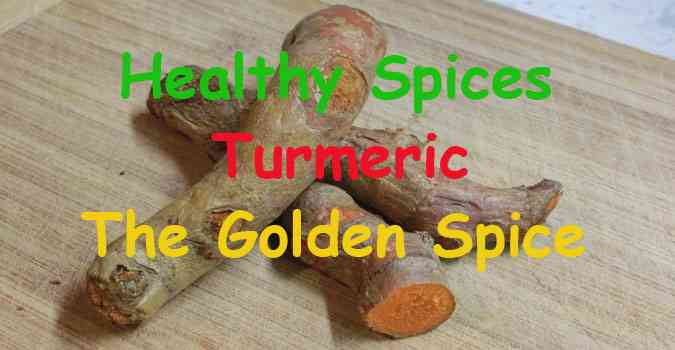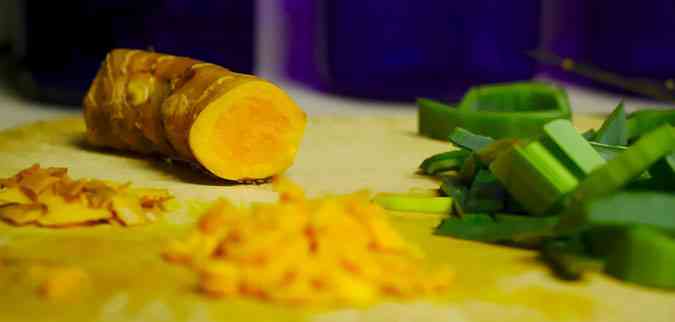Turmeric, the Golden Spice: Healthy Spices
By Krista DeKuyper | December 16, 2015 |

Welcome to this first article in our new “Healthy Spices” blog series. All spices contain varying amounts of vitamins and other nutrients, and additionally many spices actually have potent medicinal properties. In this first edition we take an in-depth look at turmeric.
We discuss its usage throughout history, and also talk about its nutritional and medicinal properties. We finish up this article by offering some suggestions on the types of dishes that turmeric goes well with along with some cautionary notes.
Historical Use of Turmeric
Turmeric has been used to spice up foods for literally thousands of year. According to some sources turmeric may have been used as far back as 4,000 years ago in ancient India.1
Turmeric was also first used in China, Africa and Jamaica. Marco Polo mentioned turmeric in 1280 AD, which he described as a vegetable that was similar in nature to saffron.
Turmeric has also been used for many centuries in South America, primarily for its medicinal properties.
It is interesting to note that turmeric has over 50 different names in Sanskrit (a classical Indian language), with each name reflecting a different property of turmeric. A great indicator for just how amazing turmeric is!
What is Turmeric?
Turmeric is a plant that belongs to the ginger family, and has the scientific name “Curcuma longa”. It grows to a height of up to a meter (3 feet), and the part that is harvested (which we buy in the stores) is actually the root of the plant.
It is native to the sub-mountain Himalayas2, and is now grown as a commercial crop in many tropical and sub-tropical areas.
Much of turmeric’s medicinal properties comes from the curcumin that turmeric contains. Curcumin is a diarylheptanoid, and it gives turmeric its yellow/orange colour.
Note that fresh turmeric root is better than older, ground-up turmeric powder when it comes to nutritional and medicinal properties.
Nutritional Properties of Turmeric
Turmeric is a rich source of vitamin B6 and vitamin C. It also contains high amounts of minerals such as calcium, iron, potassium, zinc, copper, manganese and magnesium.
In addition turmeric also contains essential oils such as curumen and termerone.
For a more complete description of turmeric’s nutritional properties please go to http://www.nutrition-and-you.com/turmeric.html.
Medicinal Properties of Turmeric
Turmeric has a plethora of medicinal properties, which is why it has been used for thousands of years now by so many different cultures.
The following lists just some of turmeric’s amazing medicinal properties:
- Turmeric is a very powerful antioxidant, due to curcumin being a phenol. Antioxidants help to reduce damage done to the body by free radicals. Free radicals affect the body at a cellular level, and are a major contributor to premature aging. In addition these free radicals may also lead (at least in part) to the onset of diseases such as cancer. How powerful is turmeric as an antioxidant? Consider this: vitamin E is well known for its antioxidant properties, and turmeric is estimated to be 8 times as powerful compared to vitamin E when it comes to being an antioxidant.
- Turmeric is a natural anti-inflammatory compound. Inflammation is necessary when it comes to fighting off foreign invaders in the body, however, many (if not most) serious medical conditions have been linked to constant, low levels of inflammation. In fact, the anti-inflammatory properties of turmeric matches that of many modern anti-inflammatory prescription drugs3!
- The curcumin in turmeric serves as an immune system boost (it is an immunomodulatory agent).
- Curcumin has been shown to help with allergies and asthma (it has anti-allergic properties that inhibits the release of histamine from mast cells4).
- There are two types of cholesterol: LDL (not good for us) and HDL (good for us). Curcumin has been found to prevent oxidation of LDL cholesterol as well as increasing the metabolism of cholesterol in the liver (thereby preventing the build-up of cholesterol in the blood).
- Turmeric also has numerous benefits for our stomachs. Just some of these benefits are:
- A digestion aid. Studies have shown that turmeric helps to release bile by stimulating the gall bladder, and bile helps us to digest food.
- Helping to prevent excessive gas (it has anti-flatulent properties).
- Reducing the number of ulcerative colitis attacks.
- Preventing gastric ulcers by increasing gastric wall mucus, which acts as a protective layer.
- Turmeric is high in fiber, which helps with conditions such as diverticulitis.
- Curcumin has anti-tumor and anti-cancer properties5. Note: studies indicate that the levels of curcumin found in turmeric are not high enough to be a potent cancer killer.
- The fiber in turmeric along with its antioxidant properties helps protect us from coronary artery disease and strokes.
- Curcumin may help to prevent or at least delay Alzheimer’s disease due to its anti-inflammatory and anti-amyloid properties.
Believe it or not, but the extensive medicinal qualities of turmeric described above are not a complete listing. Please feel free to do your own research when it comes to the medicinal uses of turmeric.
Note: turmeric is fat-soluble, so absorption is better when taken with a bit of fat. Curry has both oils and turmeric, making it a great way to absorb the curcumin.
Culinary Uses for Turmeric
Turmeric is often added to various foods for both flavor and food preservation.
Turmeric powder is common, which is made by grinding up turmeric root (fresh is better).
Turmeric goes well with any vegetable or meat dish, and it also blends well with other spices. In addition turmeric can be added to soups and salads.
In South East Asia turmeric is also added to various sweets such as ghee.
Finally, the yellow-orange colour of turmeric makes it ideal for sprinkling on top of a main dish as a garnish.
Important: one thing to be aware of is that some turmeric powders may contain additives, either as a by-product of processing or as an aid to absorption (since curcumin without fat is not absorbed overly well by the body). This is beyond the scope of this article. We leave it up to the reader to do their own research regarding the types of turmeric that are available to them.
Cautionary Notes
Generally speaking there are very few concerns when eating turmeric. This is due to the fact that its levels of curcumin are relatively low.
However, there can be side effects, especially when taking medicinal amounts of turmeric/curcumin (e.g. very high amounts).
The following should be noted when using turmeric:
- Ingesting high levels of turmeric may slow down the clotting of blood. If you are already taking medication(s) to slow clotting then be careful not to eat too much turmeric, otherwise you can end up with excessive bruising from bumps and scrapes. When in doubt consult your physician.
- If you are pregnant avoid taking medicinal amounts of turmeric. High doses may interfere with the pregnancy by promoting a menstrual period and uterine contractions.
- If you have gall stones or a bile duct obstruction avoid ingesting too much turmeric (remember that it stimulates the production of bile via the gall bladder).
- Some people have reported a skin irritation after turmeric comes into contact with their skin.
- Avoid eating large amounts of turmeric if you are already taking non-steroidal or anti-inflammatory prescription drugs.
- High turmeric levels may contribute to vomiting and/or diarrhea.
- If you are taking any of these specific prescription drug medications please note that turmeric may interfere with their action: Cimetidine (Tagamet, Famotidine (Pepcid), Ranitidine (Zantac), Esomeprazole (Nexium), Omeprazol, and Lansoprazole (Prevacid).
Conclusion
We hope you found this article about turmeric helpful.
We encourage any feedback you might have via the comments section. Have a suggestion for another Healthy Spices article? Please let us know!
Sources:































